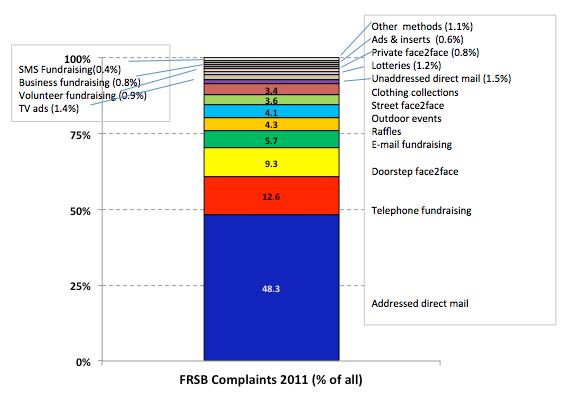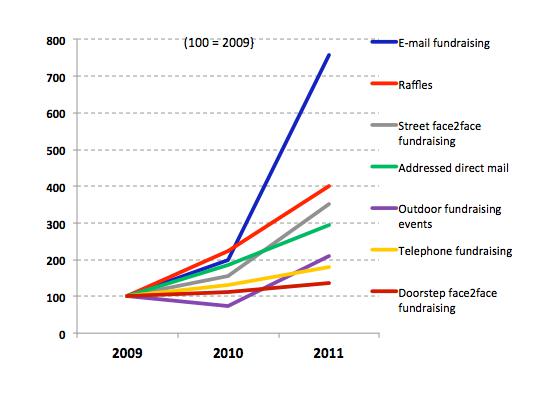‘I have a complaint to make’
The Fundraising Standards Board in the UK recently published the 2011 complaints report and, according to Andrew Papworth, it makes very interesting reading. This is an article about complaints in the UK. Could it apply to fundraising where you are?
- Written by
- Andrew Papworth
- Added
- July 01, 2012
Almost 30,000 complaints were reported to the Fundraising Standards Board (FRSB) during the year – an increase of more than 60% year-on-year. As the bar chart on the right shows, almost half the complaints related to addressed direct mail and there were substantial numbers of complaints about telephone fundraising and door-stepping. It is noteworthy that these three methods are all invasions of the Englishman’s (and woman’s) castle. Attempt to storm the ramparts at your peril.


Unfortunately, the tone of the report smacks somewhat of smugness. There is, for instance, a sentence that reads ‘However, complaints as a proportion of volume for these three areas (i.e. addressed direct mail, telephone and door-to-door fundraising) remain reassuringly low’ and the chief executive was quoted as saying that there were not many complaints ‘in the great scheme of things’. The ludicrousness of this statement is clear when it is considered that the number of complaints passed to the FRSB is more than four times the number received by the Press Complaints Commission in 2011 and nobody would regard newspapers in the UK in general as models of probity. It’s the same excuse that broadcasters make when there are complaints about a programme – ‘there were only a few thousand calls but millions of viewers’.

There are many problems in interpreting the figures – for a start 67 per cent of FRSB member charities did not report any complaints at all. It is simply not credible that two-thirds of the charities belonging to FRSB had not a single complaint in the year and, anyway, formal complaints are likely to be the iceberg’s tip compared with the number of people who have been left quietly seething and thinking worse of the charity concerned as a result of their grievances. The British tend not to complain; they simply make a mental note not to deal with the offending organisation ever again and perhaps grumble about them to anyone who will listen.
Either the 67 per cent are so perfect that they never make a mistake or misjudgement, or they don’t take reporting complaints to the FRSB seriously, or – heaven forfend – they are suppressing the information or conveniently forgetting to pass it on.
But it’s not only failure to report that casts doubt on the tone of complacency; the report is riddled with specious calculations purporting to relate the number of complaints to what they quaintly call the volume of ‘solicitations’ (It sounds like a line delivered by Frankie Howerd in Up Pompeii – if you’re old enough to remember.)

Why specious? Because they are attempting the impossible. The natures of ‘solicitations’ via direct mail shots, telephone calls, posters, TV ads, newspaper ads, magazine ads, face-to-face encounters and clothing collections are so different as to render any comparisons utterly invalid. What would be needed would be some way of calculating the proportion of complaints as a percentage of all exposures – i.e. mailshots opened and read, posters looked at, etc. But this would be impracticable because nobody has satisfactorily cracked inter-media audience comparisons. What constitutes an ‘opportunity-to-see’ in any medium may be valid within that medium but comparing apples and oranges is child’s play after attempting to compare exposures via one medium to those via another.
With magazine and newspaper ads you would have to look at readership rather than circulation and take account of page traffic and ad-noting scores. With TV ads the BARB (Broadcasters’ Audience Rating Board) ratings are not necessarily indicative of exposure to your commercial as it is well established that many people use the commercial break to go to the loo, put the kettle on, chat, or look in the programme magazines to plan the rest of their viewing. The data relating to posters amount to passages passed the site rather than people looking at the site – they can be on foot or in vehicles. Pretty well the only medium for which the gross audience is more or less the same as the advertising audience is cinema – where the commercials should be shown to a captive audience in the dark. Attempting to unravel all these differences obscures rather than enlightens.

On top of the difficulty of establishing adequate benchmarks for what constitutes an exposure, account has to be taken of the growth of FRSB membership from year to year and variations in the volumes of fundraising activity. The report claims a 636 per cent increase in expenditure on outdoor advertising in the last year; 371 per cent on radio and 202 per cent on TV – increases of this degree seem highly unlikely in such a tough economic climate. Rather than wasting time working out how many angels can dance on a pinhead, the FRSB should look at the chart above and be concerned that the trajectory is upwards for all the most common complaints and that almost 15,000 complaints is almost 15,000 too many. Then they should take steps to get all member charities to make an annual return (even if it is zero) so that we have a truer picture of where things are going wrong.

















